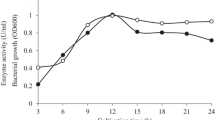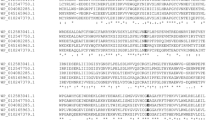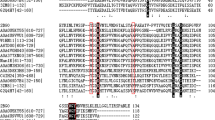Abstract
The cellulosomal enzyme, RfGH51/2, of Ruminococcus flavefaciens contains an N-terminal module, a family 5 glycoside hydrolase GH5_4 with a putative endoglucanase activity, while C-terminal domain is a putative endo-mannanase (GH5_7). The two putative catalytic modules are separated by family 80 carbohydrate binding module (CBM80) having wide ligand specificity. The putative endo-mannanase module, GH5_7 (RfGH5_7), was cloned, expressed in Escherichia coli BL-21(DE3) cells and purified. SDS-PAGE analysis of purified RfGH5_7 showed molecular size ~ 35 kDa. Substrate specificity analysis of RfGH5_7 showed maximum activity against locust bean galactomannan (298.5 U/mg) followed by konjac glucomannan (256.2 U/mg) and carob galactomannan (177.2 U/mg). RfGH5_7 showed maximum activity at optimum pH 6.0 and temperature 60 °C. RfGH5_7 displayed stability in between pH 6.0 and 9.0 and thermostability till 50 °C. 10 mM Ca2+ ions increased the enzyme activity by 33%. The melting temperature of RfGH5_7 was 84 °C that was not affected by Ca2+ ions or chelating agents. RfGH5_7 showed, Vmax, 389 U/mg and Km, 0.92 mg/mL for locust bean galactomannan. TLC analysis revealed that RfGH5_7 hydrolysed locust bean galactomannan predominantly to mannose, mannobiose, mannotriose and higher degree of polymerization of manno-oligosaccharides indicating an endo-acting catalytic mechanism. This study revealed a highly active and thermostable endo-mannanase with considerable biotechnological potential.





Similar content being viewed by others
Abbreviations
- GH:
-
Glycoside hydrolases
- Rf:
-
Ruminococcus flavefaciens
- TLC:
-
Thin-layer chromatography
- IMAC:
-
Immobilized metal ion affinity chromatography
- ESI-MS:
-
Electron spray ionization mass spectrometry
- SDS-PAGE:
-
Sodium dodecyl sulphate-polyacrylamide gel electrophoresis
References
Brett, C. T., & Waldron, K. W. (1996). Physiology and biochemistry of plant cell walls (Vol. 2). New York: Springer.
Kuhad, R. C., Singh, A., & Eriksson, K. E. L. (1997). Microorganisms and enzymes involved in the degradation of plant fiber cell walls. Biotechnology in the pulp and paper industry (pp. 45–125). Berlin: Springer.
Petkowicz, C. D. O., Reicher, F., Chanzy, H., Taravel, F. R., & Vuong, R. (2001). Linear mannan in the endosperm of Schizolobium amazonicum. Carbohydrate Polymers, 44(2), 107–112.
Liepman, A. H., Nairn, C. J., Willats, W. G., Sørensen, I., Roberts, A. W., & Keegstra, K. (2007). Functional genomic analysis supports conservation of function among cellulose synthase-like a gene family members and suggests diverse roles of mannans in plants. Plant Physiology, 143(4), 1881–1893.
Ghosh, A., Luís, A. S., Brás, J. L., Fontes, C. M., & Goyal, A. (2013). Thermostable recombinant β-(1 → 4)-mannanase from C. thermocellum: Biochemical characterization and manno-oligosaccharides production. Journal of Agricultural and Food Chemistry, 61(50), 12333–12344.
Sharma, K., Dhillon, A., & Goyal, A. (2018). Insights into structure and reaction mechanism of β-mannanases in Current Protein and Peptide. Science, 19(1), 34–47.
McCleary, B. V. (1988). Carob and guar galactomannans. Methods in enzymology (Vol. 160, pp. 523–527). Cambridge: Academic Press.
Stalbrand, H. (2003). Enzymology of endo-1,4-beta-Mannanases. Food science and technology (pp. 961–970). New York: Marcel Dekker.
Gübitz, G. M., Haltrich, D., Latal, B., & Steiner, W. (1997). Mode of depolymerisation of hemicellulose by various mannanases and xylanases in relation to their ability to bleach softwood pulp. Applied Microbiology and Biotechnology, 47(6), 658–662.
Clarke, J. H., Davidson, K., Rixon, J. E., Halstead, J. R., Fransen, M. P., Gilbert, H. J., et al. (2000). A comparison of enzyme-aided bleaching of softwood paper pulp using combinations of xylanase, mannanase and α-galactosidase. Applied Microbiology and Biotechnology, 53(6), 661–667.
Kansoh, A. L., & Nagieb, Z. A. (2004). Xylanase and mannanase enzymes from Streptomyces galbus NR and their use in biobleaching of softwood kraft pulp. Antonie van Leeuwenhoek, 85(2), 103–114.
Zhao, D., Wang, Y., Na, J., **, W., & Ge, J. (2019). The response surface optimization of β-mannanase produced by Lactobacillus casei HDS-01 and its potential in juice clarification. Preparative Biochemistry & Biotechnology, 49(2), 202–207.
Saha, D., & Bhattacharya, S. (2010). Hydrocolloids as thickening and gelling agents in food: A critical review. Journal Food Science Technology, 47(6), 587–597.
Srivastava, P. K., & Kapoor, M. (2014). Cost-effective endo-mannanase from Bacillus sp. CFR1601 and its application in generation of oligosaccharides from guar gum and as detergent additive. Preparative Biochemistry and Biotechnology, 44(4), 392–417.
Jooste, T., García-Aparicio, M. P., Brienzo, M., Van Zyl, W. H., & Görgens, J. F. (2013). Enzymatic hydrolysis of spent coffee ground. Applied Biochemistry and Biotechnology, 169(8), 2248–2262.
Suzuki, K., Michikawa, M., Sato, H., Yuki, M., Kamino, K., Ogasawara, W., et al. (2018). Purification, cloning, functional expression, structure, and characterization of a thermostable β-Mannanase from Talaromyces trachyspermus B168 and its efficiency in production of mannooligosaccharides from coffee wastes. Journal of Applied Glycoscience, 65(2), 13–21.
Cartmell, A., Topakas, E., Ducros, V. M., Suits, M. D., Davies, G. J., & Gilbert, H. J. (2008). The Cellvibrio japonicus mannanase CjMan26C displays a unique exo-mode of action that is conferred by subtle changes to the distal region of the active site. Journal of Biological Chemistry, 283(49), 34403–34413.
Fontes, C. M., & Gilbert, H. J. (2010). Cellulosomes: highly efficient nanomachines designed to deconstruct plant cell wall complex carbohydrates. Annual Review of Biochemistry, 79, 655–681.
Asano, I., Hamaguchi, K., Fujii, S., & Iino, H. (2003). In vitro digestibility and fermentation of mannooligosaccharides from coffee mannan. Food Science and Technology Research, 9(1), 62–66.
Asano, I., Ikeda, Y., Fujii, S., & Iino, H. (2007). Effects of mannooligosaccharides from coffee on microbiota and short chain fatty acids in rat cecum. Food Science and Technology Research, 10(3), 273–277.
Kim, Y. J., & Park, G. G. (2005). Identification and growth activity to Bifidobacterium spp. of Locust Bean Gum Hydrolysates by Trichoderma harzianum β-mannanase. Journal of the Korean Society for Applied Biological Chemistry, 48(4), 364–369.
Hoshino-Takao, I., Fujii, S., Ishii, A., Han, L. K., Okuda, H., & Kumao, T. (2008). Effects of mannooligosaccharides from coffee mannan on blood pressure in dahl salt-sensitive rats. Journal of Nutritional Science and Vitaminology, 54(2), 181–184.
Ghosh, A., Verma, A. K., Tingirikari, J. R., Shukla, R., & Goyal, A. (2015). Recovery and purification of oligosaccharides from copra meal by recombinant endo-β-mannanase and deciphering molecular mechanism involved and its role as potent therapeutic agent. Molecular Biotechnology, 57(2), 111–127.
Venditto, I., Luis, A. S., Rydahl, M., Schückel, J., Fernandes, V. O., Vidal-Melgosa, S., et al. (2016). Complexity of the Ruminococcus flavefaciens cellulosome reflects an expansion in glycan recognition. Proceedings of the National Academy of Sciences USA, 113(26), 7136–7141.
Bradford, M. M. (1976). A rapid and sensitive method for the quantitation of microgram quantities of protein utilizing the principle of protein-dye binding. Analytical Biochemistry, 72(1–2), 248–254.
Nelson, N. (1944). A photometric adaptation of the Somogyi method for the determination of glucose. Journal of Biological Chemistry, 153(2), 375–380.
Somogyi, M. (1945). A new reagent for the determination of sugars. Journal of Biological Chemistry, 160, 61–68.
Kurokawa, J., Hem**da, E., Arai, T., Karita, S., Kimura, T., Sakka, K., et al. (2001). Sequence of the Clostridium thermocellum mannanase gene man26B and characterization of the translated product. Bioscience, Biotechnology, and Biochemistry, 65(3), 548–554.
Zang, H., **e, S., Wu, H., Wang, W., Shao, X., Wu, L., et al. (2015). A novel thermostable GH5_7 β-mannanase from Bacillus pumilus GBSW19 and its application in manno-oligosaccharides (MOS) production. Enzyme and Microbial Technology, 78, 1–9.
Yang, P., Li, Y., Wang, Y., Meng, K., Luo, H., Yuan, T., et al. (2009). A novel β-mannanase with high specific activity from Bacillus circulans CGMCC1554: Gene cloning, expression and enzymatic characterization. Applied Biochemistry and Biotechnology, 159(1), 85.
Vu, T. T., Quyen, D. T., Dao, T. T., & Nguyen, S. L. T. (2012). Cloning, high-level expression, purification, and properties of a novel endo-beta-1, 4-mannanase from Bacillus subtilis G1 in Pichia pastoris. Journal of Microbiology and Biotechnololy, 22(3), 331–338.8.
Tamaru, Y., & Doi, R. H. (2000). The engL gene cluster of Clostridium cellulovorans contains a gene for cellulosomal ManA. Journal of Bacteriology, 182(1), 244–247.
Wang, Y., Vilaplana, F., Brumer, H., & Aspeborg, H. (2014). Enzymatic characterization of a glycoside hydrolase family 5 subfamily 7 (GH5_7) mannanase from Arabidopsis thaliana. Planta, 239(3), 653–665.
Sakai, K., Mochizuki, M., Yamada, M., Shinzawa, Y., Minezawa, M., Kimoto, S., et al. (2017). Biochemical characterization of thermostable β-1, 4-mannanase belonging to the glycoside hydrolase family 134 from Aspergillus oryzae. Applied Microbiology and Biotechnology, 101(8), 3237–3245.
Wang, Y., Shi, P., Luo, H., Bai, Y., Huang, H., Yang, P., et al. (2012). Cloning, over-expression and characterization of an alkali-tolerant endo-β-1, 4-mannanase from Penicillium freii F63. Journal of Bioscience and Bioengineering, 113(6), 710–714.
Acknowledgements
This research work was supported by NERBPMC Twinning project from DBT (No. BT/PR24786/NER/95/853/2017), Ministry of Science and Technology, Govt. of India to AG. The authors are thankful to Central Instrumentation Facility, IIT Guwahati for providing ESI-MS facility. The authors are thankful to Vikky Rajulapati for his help in ESI-MS analysis.
Author information
Authors and Affiliations
Corresponding author
Ethics declarations
Conflict of interest
The authors declare no conflict of interest.
Additional information
Publisher's Note
Springer Nature remains neutral with regard to jurisdictional claims in published maps and institutional affiliations.
Rights and permissions
About this article
Cite this article
Goyal, D., Kumar, K., Centeno, M.S.J. et al. Molecular Cloning, Expression and Biochemical Characterization of a Family 5 Glycoside Hydrolase First Endo-Mannanase (RfGH5_7) from Ruminococcus flavefaciens FD-1 v3. Mol Biotechnol 61, 826–835 (2019). https://doi.org/10.1007/s12033-019-00205-2
Published:
Issue Date:
DOI: https://doi.org/10.1007/s12033-019-00205-2




